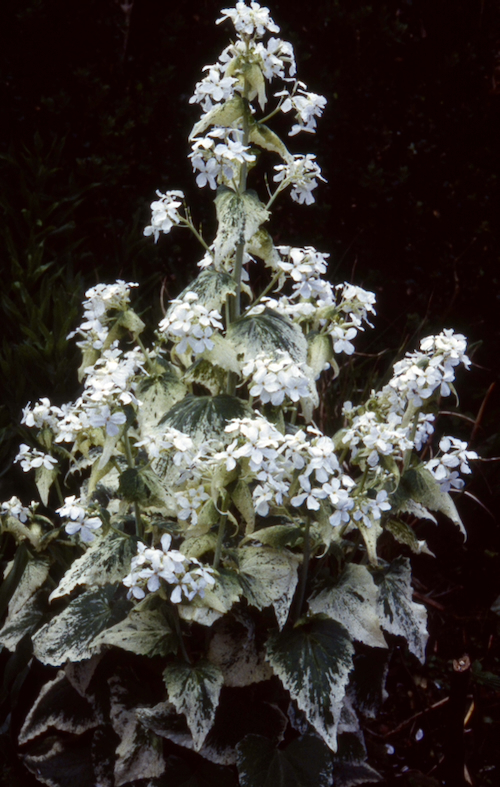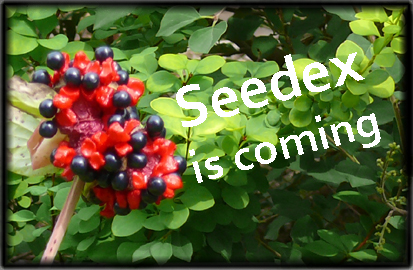
Plant of the Month - June 2022
GENERAL INFORMATION: The Oxalidaceae or wood sorrel family has five genera. Oxalis is the largest genus with over 550 herbaceous species. The other four genera have 15 species, some of which are woody.
Oxalis distribution is world wide with many species in tropical South America, Brazil and Mexico. The wood sorrel group has an acid taste and are mostly annual or perennial. Oxalis stricta, O. dillenii, O. corniculata, are similar looking weeds in our southern Ontario gardens.
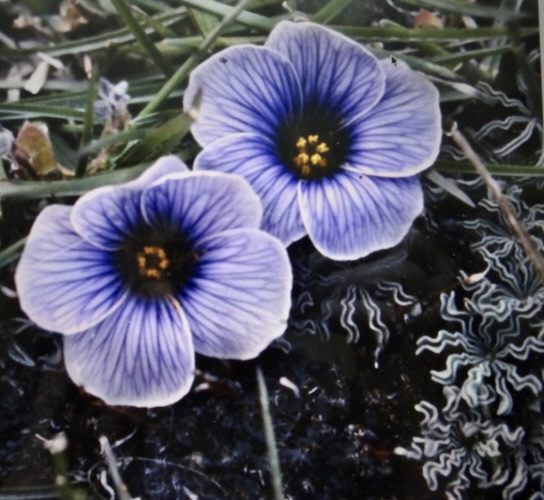

Oxalis laciniata Estancia Stag River Oxalis adenophylla Cerro Chapelco
There are several desirable Oxalis species in South Africa and Patagonia. I saw several lovely forms of rosy purple Oxalis enneaphylla and purplish O. laciniata growing up to 1100 m in cold, wind swept grassland at Estancia Stag River in Southern Patagonia. There are several forms in cultivation.
Oxalis erythrorhiza grows in the Andes above the tree line to 4000 m, forming hard mounds with yellow flowers.
Oxalis adenophylla grows around the tree line in more or less level open screes.
Common Name: Silver Shamrock, Pink Buttercups.

Oxalis adenophylla in our garden
Cultivars: Oxalis adenophylla ‘Purple Heart’ has leaflets with a purplish base, O. a. ‘Brenda Anderson’, O.a. ‘Tora’ and other white and purple forms are all difficult to find.
Life Cycle: Stemless, perennial, whiskery corm.
Height: to 10 cm, spreading to 30 cm.
Bloom Time: May to early June in Toronto.
Flower Colour & Size: Open funnel-shaped, 2-5 cm long. 5 pink petals fading to white at the base. They have darker pink veins and a purple marked throat. Petals are twisted in bud.
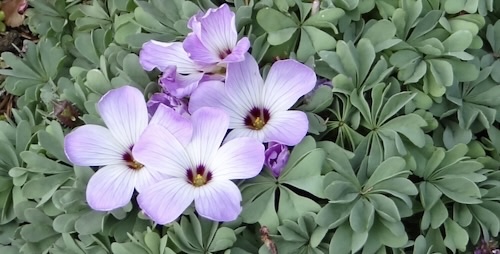
Oxalis adenophylla flowers and leaves
Leaves: Clover like. Compound silver green heart shaped leaflets, in clusters of 9 to 20. Closed at night.
Range: Argentinian & Chilean Andes.
Habitat: Screes, flat open areas, near or above the tree line.
CULTIVATION:
Plant: To 7.5 cm deep, with fibrous roots down.
Light: Full sun to semi shade.
Soil: Rock Garden: Well drained and fairly fertile. Most types of soil.
Water: Moderate amounts when in full growth.
USDA Hardiness: Zone 4-9.
Companion planting: Other short rock garden plants.
Propagation: Divide corms and replant in the fall. Rarely sets seeds. If it does - small capsule with several seeds.
Problems: Corms rot with winter wet. Survives freezing.
References:
Encyclopedia of Alpines; AGS Publications 1994
http://www.llifle.com/Encyclopedia/BULBS
https://www.shootgardening.co.uk/plant/oxalis-adenophylla
http://www.omafra.gov.on.ca/english/crops/facts/ontweeds/commonyel_woodsorrel.htm
Text and images supplied by Anna Leggatt

Plant of the Month: May 2022
GENERAL INFORMATION:
Fritillaria imperialis is one of the earliest wild flowers to be grown in our gardens. John Gerard (Gerard’s Herbal) grew them in London, England, in the late 1500s. He wrote “…. hath for his root a thick firm and solid bulb, covered with a yellowish film or skin, from the which riseth up a great thick fat stalk two cubits high, in the bare and naked part of a dark overworn dusky purple colour. The leaves grow confusedly about the (lower half of the) stalk like those of the white Lily, but narrower: the flowers grow at the top of the stalk, encompassing it round in form of an Imperial crown” There is a cluster of leaves crowning the ring of flowers. Perdita’s (in Shakespeare’s “A Winter’s Tale”) bouquet has “bold oxlips and the Crown Imperial”.
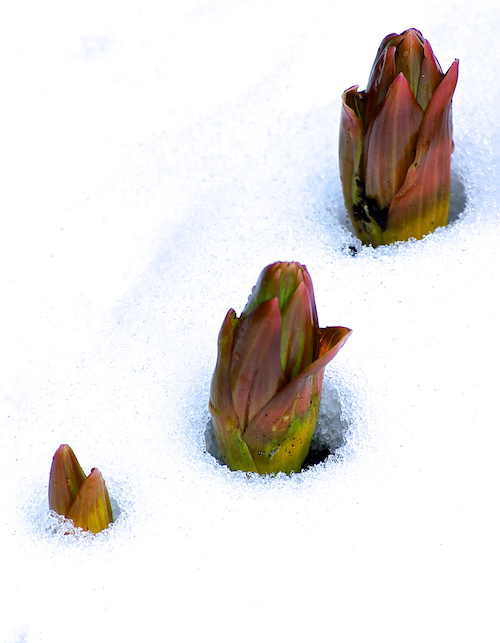
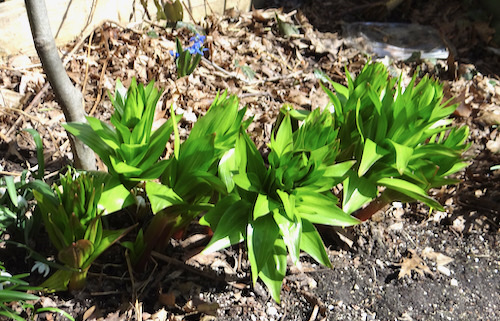
Fritillaria imperialis early April Mid April
The European Blue Tit is a pollinator.
The first owner of our house planted some here, before 1970. Perhaps in the 1950s. The clump is still here in the same place. I have carefully removed bulbs from the outer edges.
Common Name: Crown Imperial Fritillary, Kaiser’s Crown.
Cultivars: many -
Fritillaria imperialis ‘Rubra maxima’ red-orange.
Fritillaria imperialis ‘Maxima Lutea’ large yellow.
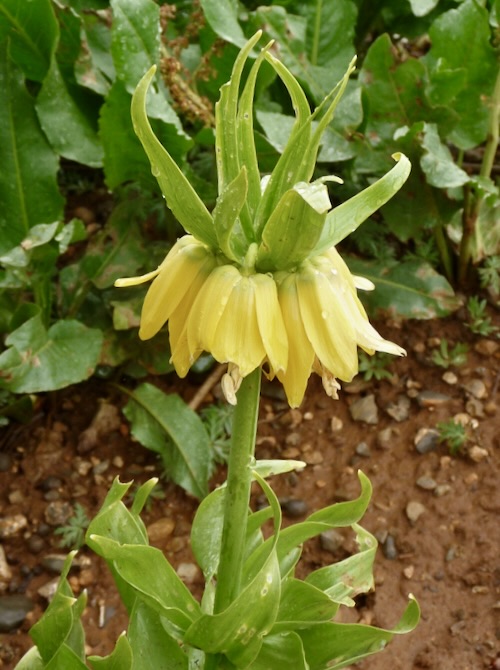 Fritillaria imperialis var. lutea in wild
Fritillaria imperialis var. lutea in wild
Fritillaria imperialis ‘Garland Star’ curly leaves, orange red colouring.
The Composer series are shorter. Fritillaria imperialis ‘Chopin’ is 60 cm with small yellow-orange flowers. F. i. ’Brahms’ has salmon-pink flowers.
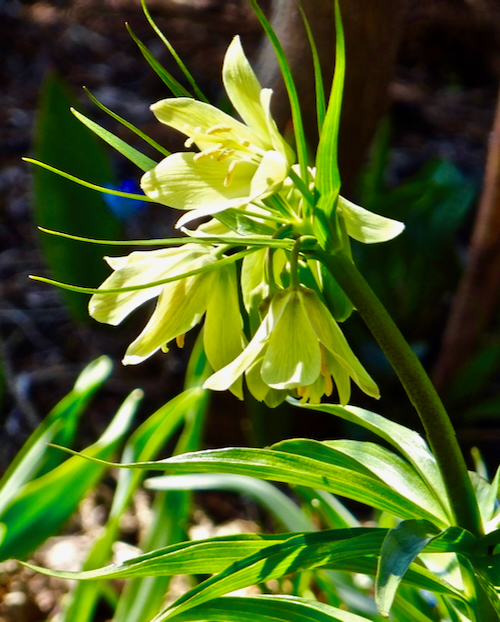
Fritillaria imperialis ‘Chopin’
Fritillaria imperialis ‘Aureo-marginata’ - yellow and green variegated leaves.
Fritillaria imperialis ‘Kroon op Kroon’ Double layer of bells.
Life Cycle: Perennial bulb.
Height: 0.5 - 1.5m
Bloom Time: Late April - May in Southern Ontario.
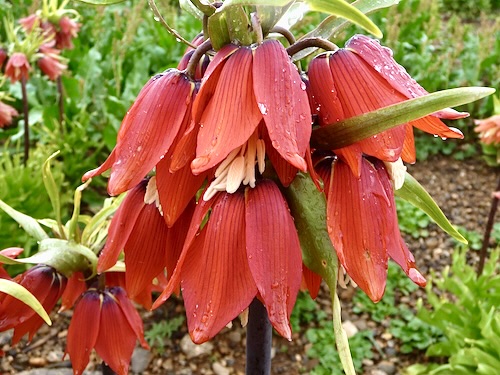
Fritillaria imperialis 'Kroon' type in wild
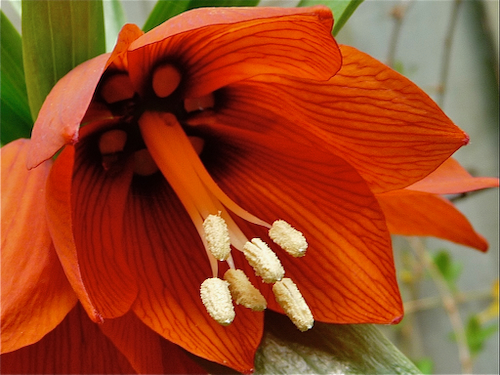
Flower Colour & Size: Ring of perhaps 10, red-orange or yellow, down or slightly outfacing 6-tepelled chunky bells, often dark at the base. The bells are up to 8 cm long. Copious nectar. Stamens exserted.
Scent: Skunk-like smell from bulbs and leaves. Deters deer and rodents.
Stems: Dark green to almost black.
Leaves: Glossy green, lance shaped, on the lower part of the flowering stem, also forming the “crown”.
Range: Central Turkey, east to the Himalayan foothills.
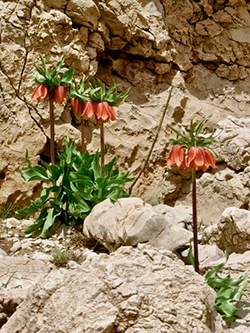
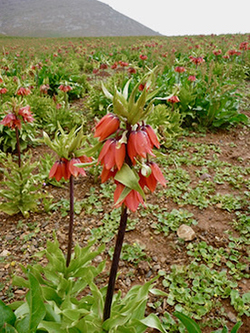

Habitat: Fritillaria imperialis in Iran - screes, clay valley bottoms, grassy areas.
CULTIVATION:
Plant: bulbs 25-30 cm deep, with the tip pointing up. Add a layer of sand compost below your bulb. Ignore the hole left by the dead stalk. Add some compost as you refill.
Light: Full sun to some afternoon shade. Deciduous shade from late opening shrubs is fine.
Soil: Deep and well drained, nutrient medium rich. Mulch in winter.
Water: Water well in active growth. Mulch with compost and add bulb fertilizer as directed. Minimum water in summer when the bulbs are dormant. Summers are hot and dry in their native habitat where the surface soil is very dry, wth some moisture deep down.
USDA Hardiness: Zones 5-9
Companion planting: Other spring bulbs, Hosta, ferns, Forsythia.
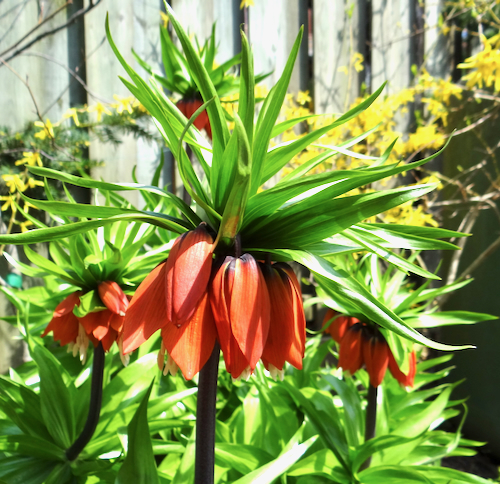
Fritillatia imperialis with Forsythia
Propagation: seed, bulb offshoots.
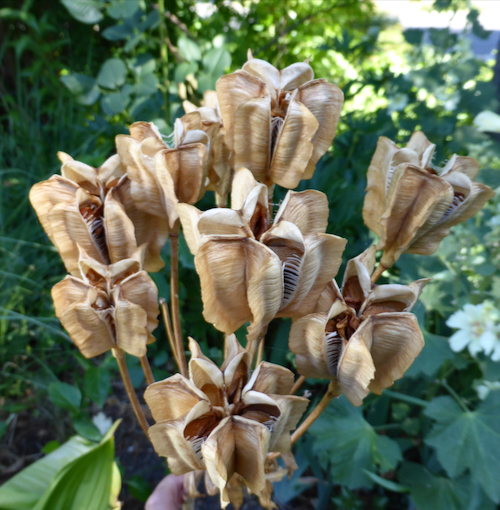
Fritillaria Seeds
Seedex availability: Occasionally ORG&HPS annual Seed Exchange.
Germination Tips: Fresh seed germinates best. Otherwise, plant and leave pot at 4°C, then 20°C for 3 months each. Repeat cycles. Do not transplant for 2 years. Flowering may be 5 years after germination.
Problems: Poisonous.
Check for Lily Beetle in the early spring. Hand removal is best.
References: Wikipedia
https://www.plantopedia.com/fritillaria-imperialis
Gerard’s Herball 1597
Text and images supplied by Anna Leggatt
Plant of the Month: April 2022

Sanguinaria canadensis f. multiplex ‘Plena’
Sanguinaria canadensis, the common Bloodroot, carpets our woodland floors in early spring as the buds overhead start to swell. Their beauty is fleeting - true spring ephemerals. Petals soon drop after pollination, which occurs in a few days.
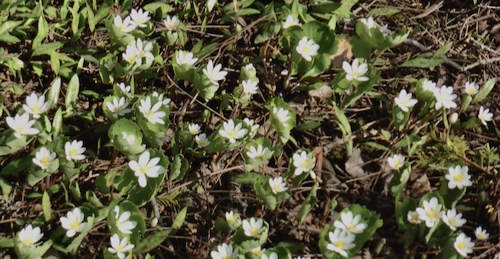
Sanguinaria canadensis in wild
However, a double, longer lasting form with multi-petals was found in 1916 in Dayton, Ohio. This is sterile, with only petals, so there is no fertilization to trigger petal drop. It was thought to be lost, but had been propagated in Montreal Botanical Garden. Today, Sanguinaria canadensis f. multiplex ‘Plena’ is available in many specialized nurseries and society plant sales. It is a handsome addition to the spring garden. All plants we grow are clones of the original plant.

Sanguinaria canadensis f. multiplex ‘Plena’
It is a member of the Papaveraceae (the poppy family) and contains a coloured, alkaloid rich, toxic latex like many of this family. Here, the latex is red (sanguine). The First Nations used this for traditional medicine, to colour baskets, clothing, war paint and as an insect repellant.
GENERAL INFORMATION:
Synonyms: Sanguinaria canadensis var. rotundifolia, Sanguinaria canadensis ‘Multiplex’
Common Name: Bloodroot, Puccoon
Life Cycle: Perennial rhizome
Height: 20 cm
Bloom Time: April - May
Flower Colour & Size: Pure white, solitary, 7 cm wide. Sometimes bluish in bud.
Leaves: Simple, bluish grey green, round, with scalloped edges. One leaf clasps each flower stalk till it opens. Leaves become dormant in mid-late summer.
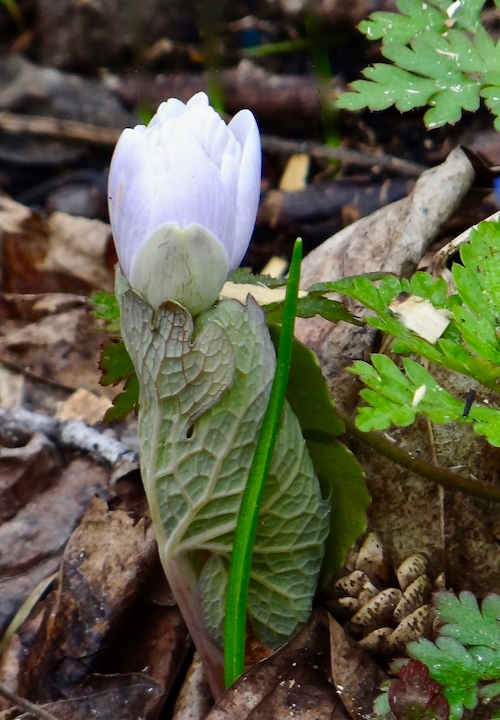
Emerging flower protected by leaf
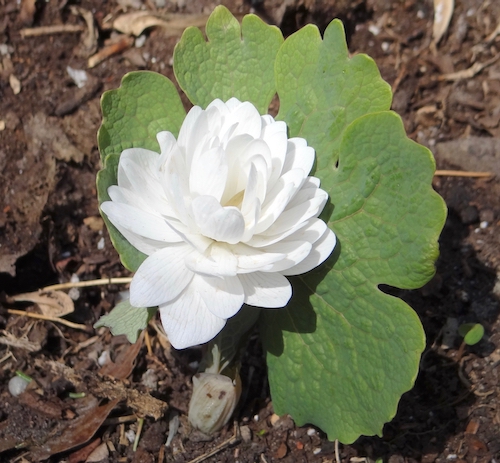
Open flower
Range: From Quebec to Manitoba, south to Florida and Texas.
Habitat: Rich, deciduous woodland.
CULTIVATION:
Plant rhizomes just below the soil surface. Toxic - use gloves. It will slowly form attractive clumps. Mulch with deciduous leaves in the fall.
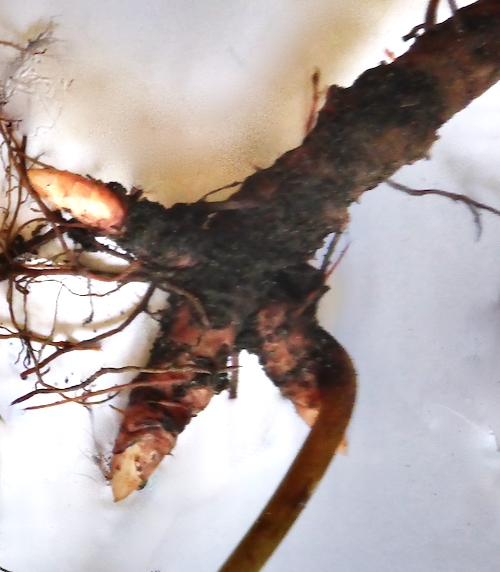
Sanguinaria rhizome
Light: Shade, part shade.
Soil: Humus rich. pH 7, around neutral.
Water: Moist, well drained.
USDA Hardiness: Zone 3 - 8b.
Companion Plants: Native woodlanders, other spring bulbs, small ferns, Hosta, clumping Epimedium.
Propagation: Division of rhizomes when leaves die down
Seedex availability: No seed - flowers sterile
Problems: Unexplained death. Many clumps suddenly died in many gardens a few years ago. Luckily I had one clump left. Could it be clonal age? - all the same age! My present clumps seem healthy. Divide every three or four years.
Toxicity: Plants for a Future (pfaf.org) states that the plant, especially the roots are toxic, and contain a number of opium-like alkaloids. It is anaesthetic, cathartic, emetic, expectorant, diuretic, febrifuge, sedative, stimulant. It is taken internally in the treatment of bronchial, respiratory tract and throat infections, and poor peripheral circulation. It is used in traditional medicine but needs medical supervision. The extract, sanguinarine, was used in toothpaste and mouthwash about 20 years ago but has been withdrawn.
References: Encyclopedia of Alpines; AGS Publications 1994
Plants for a Future (pfaf.org)
(Text and images contributed by Anna Leggatt)
Plant of the Month for March 2022

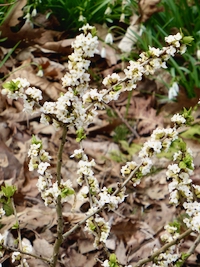
Daphne mezereum f. alba
GENERAL INFORMATION:
Daphne mezereum f. alba is an early flowering shrub. One name is February Daphne. Our climate in Southern Ontario is too cold for this name to fit! They flower in England in mid February. The flower buds open here in late March. Buds form in the fall and are clustered alternately along the ends of the twigs. The flowers are fragrant, small, whitish, 4-petalled and tubular. Small leaves appear as the clusters of flowers fully open. These leaves are 2 cm long, more or less elliptical and mid dull green.
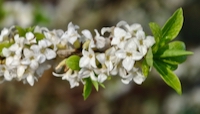
Daphne mezereum f. alba - flowers
Green berries (actually drupes, 6 mm long) turn orange in July. They fall off at the touch when ripe and are often eaten by birds and chipmunks. Uneaten seeds readily germinate under the parent plant.
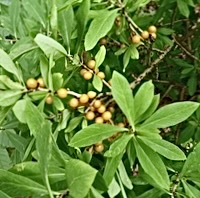
Daphne mezereum f. alba - berries
The berries, sap and bark are poisonous.
Life Cycle: Small deciduous shrub.
Size: 1-1.5m tall, 1m wide after about 10 years.
Bloom Time: March, April.
Native to: Europe across to Siberia.
Habitat: Woodland, forest margins.
Cultivars: D. m. f alba ’Bowles’ White’ and ‘Paul’s White’ are said to have purer white flowers. It is unlikely these are still available due to DSDS (see below) and seed sourced supplies.
CULTIVATION:
Light: Part shade to full sun. Protect from hot weather.
Soil: Well drained, neutral to alkaline, fertile but moisture retentive. Small plants succeed best as Daphne resents root disturbance.
Water: Mulch to prevent water loss
USDA Hardiness: Zone 4-7
Companion plants: Snowdrops and other early spring bulbs, hellebores, small hosta
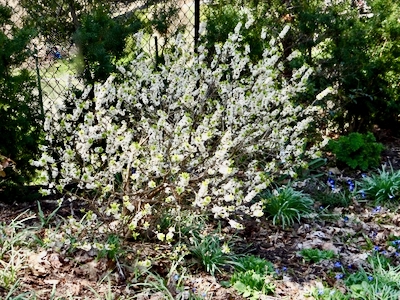
Daphne mezereum f. alba with spring bulbs
Pruning: Minimum. Remove dead or damaged wood.
Problems: All my shrubs have died between 5 and 10 years of age. I find a plant has wilted overnight. This is probably Daphne Sudden Death Syndrome (DSDS), a disease that suddenly kills the plant. There is nothing to do to treat this fungus. Avoid cutting older branches helps. Luckily my plants have been replaced by seedlings growing under their parent.
Flower buds survive low temperatures till they start to open. Then very low temperatures will damage them.
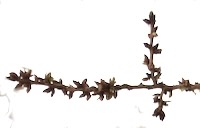
Daphne mezereum f. alba - winter twig
Mulching is important to prevent the roots from drying out. Watch for aphids. We have plenty of birds which seem to keep problem insects at bay.
Propagation: Seed, root, softwood and hardwood cuttings. I have not attempted cuttings.
Seedex availability: Usually ORG&HPS Annual Seed Exchange
Germination Tips: Remove pulp and plant fresh outside. If dry, rub gently with sandpaper, soak in warm water. Then repeated cycles of 4°C, then 20°C for 3 months each.
(Text and images contributed by Anna Leggatt)
Plant of the Month for February, 2022

Eranthis hyemalis, the winter aconite, is an early bloomer, heralding spring. It often flowers through the snow, soon after the first snowdrops.
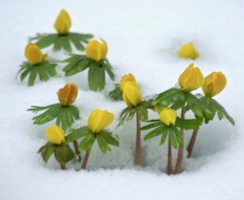
Eranthis in the Snow
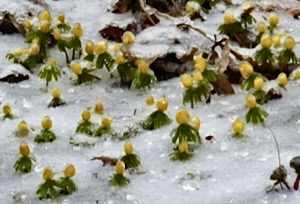
Eranthis in Ice
A curved stalk drags up a flower bud, surrounded by finger-like bracts. It straightens, opening to a 5-8 (usually 6) sepalled yellow cup above a ruff of bright green bracts. Petals are reduced to nectaries. Central follicles are surrounded by numerous stamens. Leaves, similar to the bracts, grow up as the flowers mature.
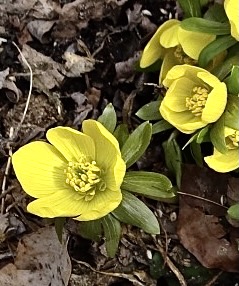
I remember a patch several metres wide in England when I was a child. My Grandmother planted them in the 1920s. They were still there in 2009!
Other Species and Cultivars:
There are eight species and many cultivars. These include:
Eranthis cilicicia (Cilicicia Group) blooms a little later with slightly larger flowers and more deeply dissected bracts and leaves.
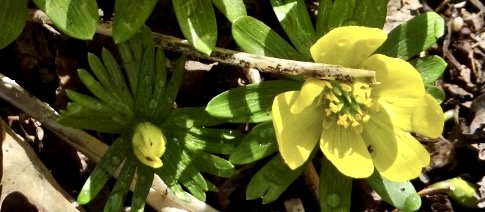
Eranthis x tubergenii is a hybrid between these two species with larger, sterile flowers
Eranthis x tubergenii ‘Guinea Gold’ has deeper yellow flowers, bronze leaves and is scented
Eranthis pinnatifida and Eranthis stellata are white flowered.
Eranthis hyemalis ‘Flore Pleno’ is one of several double cultivars
Eranthis hyemalis ‘Moonlight’ is light yellow, found in an Ithaca NY garden.
General information:
Life Cycle: Long lived perennial tuber
Dimensions: Inflorescence 2.5 cm across. Height 10-15 cm tall as the flowers mature
Bloom time: Late February to April. The leaves die down as shade increases and the soil dries.
Distribution: E. hyemalis is native to eastern Europe to Iraq. E. cilicicia - western to central Asia. The white species grow in the far east.
Habitat: Woodlands
Cultivation: Buy tubers in the fall as early as possible. Soak in luke warm water for 12 hours before planting in groups 5-10 cm deep, in deciduous shade to morning sun. They will soon clump up and form a mat. They can grow in a lawn. However, do not mow till the leaves start to wither.
Companion plants: Crocus, Hellebores, Hosta
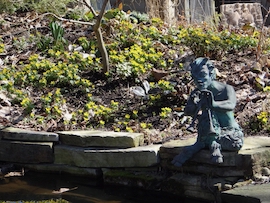
Eranthis self seeding on mound
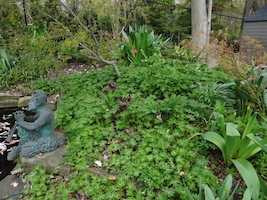
Soil: Humus rich alkaline to neutral well drained soil.
Water: Do not let it dry out when dormant.
Hardiness: USDA Zone 4-7
Propagation: Plant “In the green”. Dig up clumps after flowering, divide and replant.
Seeds are recalcitrant. Direct sow outside as soon as the seeds turn from green to black. They will germinate in the late winter, with the seedlings emerging as the plants flower. They withstand frost.
I have had no success with Eranthis seeds from exchanges.
Notes: It is toxic like all members of the Ranunculaceae. Don’t nibble on the plant! Symptoms of poisoning include vomiting, diarrhoea, disturbed vision and cardiac arrest.
Animals avoid eating leaves.
No pests or diseases.
Source of pollen and nectar for early pollinators.
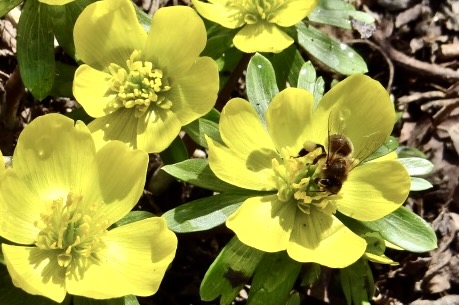
 I have 100s of plants, nearly all E. hyemalis. There are a few E. cilicicia or perhaps the hybrid. Dry summers may have reduced the numbers of the later.
I have 100s of plants, nearly all E. hyemalis. There are a few E. cilicicia or perhaps the hybrid. Dry summers may have reduced the numbers of the later.
I am looking for other cultivars.
For more information:
https://www.pacificbulbsociety.org/pbswiki/index.php/Eranthis
(Text and Images contributed by Anna Leggatt)

